The Manufacture of Tempered Glass A Comprehensive Overview
Tempered glass, also known as toughened glass, plays a pivotal role in modern architecture, automotive design, and various industrial applications due to its enhanced strength and safety features. This specially treated glass is designed to withstand high stresses and thermal fluctuations, making it an ideal choice for environments where safety and durability are paramount. The manufacturing process of tempered glass involves several critical steps, from raw material selection to the final tempering, each contributing to the glass's overall properties.
Raw Material Selection
The manufacturing process of tempered glass begins with the selection of high-quality raw materials, primarily silica sand. Silica is combined with various additives such as soda ash, limestone, and alumina, which help to modify the glass properties for specific applications. The purity and composition of these raw materials are crucial, as they directly affect the clarity, strength, and overall quality of the finished product. Once the materials are collected, they are thoroughly mixed and melted in a furnace at temperatures reaching around 1600 degrees Celsius (approximately 2912 degrees Fahrenheit).
Melting and Forming
The molten glass is then shaped into sheets through various forming processes. One of the most common methods is the float glass process, which involves pouring the molten glass onto a bed of molten tin. This technique allows the glass to spread evenly and form a smooth, flat surface as it cools. The resulting glass sheet is then annealed to relieve internal stresses before it undergoes the tempering process.
Cutting and Edge Finishing
Once the glass has cooled and solidified, it is cut to the desired dimensions. This step requires precision and care, as tempered glass cannot be re-cut or modified after it has been treated. Cutting is followed by edge finishing, which involves grinding and polishing the edges to eliminate sharp points and ensure safe handling. Proper edge finishing is critical, as poorly finished edges can lead to stress concentration, potentially making the glass susceptible to breakage.
tempered glass manufacture
Tempering Process
The tempering process is where glass transforms into tempered glass. This process involves heating the glass to a temperature of about 620 degrees Celsius (approximately 1148 degrees Fahrenheit) in a tempering furnace. The heating stage lasts for several minutes, during which the glass is uniformly heated to ensure consistent physical properties throughout the entire sheet. Following heating, the glass is rapidly cooled through a process known as quenching. High-pressure air jets create a drastic temperature differential between the exterior and the interior of the glass, resulting in compressive stresses on the surface and tensile stresses in the core. This unique combination of stresses provides tempered glass with its superior strength, making it approximately five to six times stronger than standard glass of the same thickness.
Quality Control and Testing
Following the tempering process, it's essential to implement quality control measures to ensure the safety and reliability of the tempered glass. Manufacturers conduct rigorous tests, including impact resistance tests, thermal shock tests, and visual inspections for surface flaws or imperfections. These checks are vital to ascertain that the glass meets industry standards and can withstand the conditions it will face in its intended applications.
Applications of Tempered Glass
Due to its enhanced properties, tempered glass has a wide array of applications. In architecture, it is commonly used for windows, facades, and shower enclosures, providing not only safety but also aesthetic appeal. In the automotive industry, tempered glass is used for side and rear windows, ensuring passenger safety while also offering clarity and style. Additionally, tempered glass finds its way into various industries, such as railways, solar panels, and even the manufacturing of electronic screens, owing to its resilience and versatility.
Conclusion
The manufacture of tempered glass is a sophisticated process that combines advanced technology with careful craftsmanship. From selecting high-quality raw materials to the intricate tempering stages, each step is designed to enhance the glass's strength and safety. As demand for durable and secure materials continues to grow, tempered glass will undoubtedly remain a vital component in shaping the future of construction, automotive design, and beyond.
 Afrikaans
Afrikaans  Albanian
Albanian  Amharic
Amharic  Arabic
Arabic  Armenian
Armenian  Azerbaijani
Azerbaijani  Basque
Basque  Belarusian
Belarusian  Bengali
Bengali  Bosnian
Bosnian  Bulgarian
Bulgarian  Catalan
Catalan  Cebuano
Cebuano  Corsican
Corsican  Croatian
Croatian  Czech
Czech  Danish
Danish  Dutch
Dutch  English
English  Esperanto
Esperanto  Estonian
Estonian  Finnish
Finnish  French
French  Frisian
Frisian  Galician
Galician  Georgian
Georgian  German
German  Greek
Greek  Gujarati
Gujarati  Haitian Creole
Haitian Creole  hausa
hausa  hawaiian
hawaiian  Hebrew
Hebrew  Hindi
Hindi  Miao
Miao  Hungarian
Hungarian  Icelandic
Icelandic  igbo
igbo  Indonesian
Indonesian  irish
irish  Italian
Italian  Japanese
Japanese  Javanese
Javanese  Kannada
Kannada  kazakh
kazakh  Khmer
Khmer  Rwandese
Rwandese  Korean
Korean  Kurdish
Kurdish  Kyrgyz
Kyrgyz  Lao
Lao  Latin
Latin  Latvian
Latvian  Lithuanian
Lithuanian  Luxembourgish
Luxembourgish  Macedonian
Macedonian  Malgashi
Malgashi  Malay
Malay  Malayalam
Malayalam  Maltese
Maltese  Maori
Maori  Marathi
Marathi  Mongolian
Mongolian  Myanmar
Myanmar  Nepali
Nepali  Norwegian
Norwegian  Norwegian
Norwegian  Occitan
Occitan  Pashto
Pashto  Persian
Persian  Polish
Polish  Portuguese
Portuguese  Punjabi
Punjabi  Romanian
Romanian  Russian
Russian  Samoan
Samoan  Scottish Gaelic
Scottish Gaelic  Serbian
Serbian  Sesotho
Sesotho  Shona
Shona  Sindhi
Sindhi  Sinhala
Sinhala  Slovak
Slovak  Slovenian
Slovenian  Somali
Somali  Spanish
Spanish  Sundanese
Sundanese  Swahili
Swahili  Swedish
Swedish  Tagalog
Tagalog  Tajik
Tajik  Tamil
Tamil  Tatar
Tatar  Telugu
Telugu  Thai
Thai  Turkish
Turkish  Turkmen
Turkmen  Ukrainian
Ukrainian  Urdu
Urdu  Uighur
Uighur  Uzbek
Uzbek  Vietnamese
Vietnamese  Welsh
Welsh  Bantu
Bantu  Yiddish
Yiddish  Yoruba
Yoruba  Zulu
Zulu 

